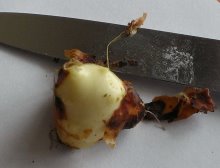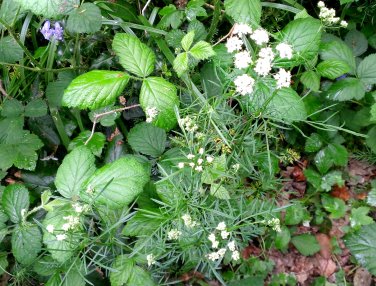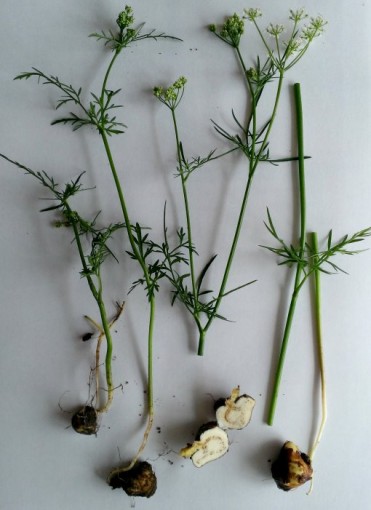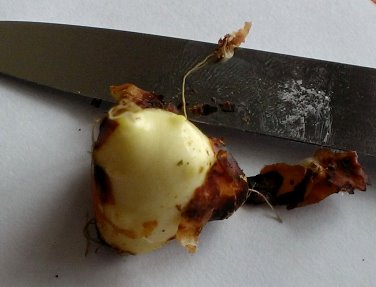Earthnuts
By Mike on Monday, May 20, 2013, 23:56 - Permalink
 May 2013 - Time for Earthnuts - not actually a nut, but they do grow in the earth - and they are somewhat nutty!
May 2013 - Time for Earthnuts - not actually a nut, but they do grow in the earth - and they are somewhat nutty!
What Are Earthnuts?
 Conopodium majus - a slender umbellifer - related to carrots and cow-parsley, with delicate, loose heads of creamy-white flowers, stiff upright stems and finely-cut deep green leaves that may appear grass or fern-like.
Conopodium majus - a slender umbellifer - related to carrots and cow-parsley, with delicate, loose heads of creamy-white flowers, stiff upright stems and finely-cut deep green leaves that may appear grass or fern-like.
The plant is biennial - forming a small underground tuber in its first year of growth, then producing flowers and seeds the next year.
It is found in open woodland, damp pastures and meadows.
A Closer Look
The plant may be anywhere between 10 and 75cm tall - some specimens being quite bushy and others hardly having any discernible leaves at all.
At the bottom of the stem, attached only by a very thin and brittle stalk, is a small knobbly and irregular tuber, usually no more than about 2.5cm across - and sometimes much smaller.

Gathering Earthnuts
 Don't try to pull them up by the stalk - this will certainly fail, as the tubers are about 10cm underground and the stalks are not strongly attached - you will need to dig them up with a trowel or similar.
Don't try to pull them up by the stalk - this will certainly fail, as the tubers are about 10cm underground and the stalks are not strongly attached - you will need to dig them up with a trowel or similar.
If you find them growing up through a tangle of other plants and their roots - give up and look elsewhere - because you'll often simply be unable to find the tuber - the best method it to carefully dig and trace the stem all the way down. The stalk is often twisted or curved in such way that the tuber is not directly beneath the visible parts of the plant.
Eating Earthnuts
 The tubers can be scrubbed, rubbed or scraped and the soft skin will come away easily, revealing the beautiful polished-ivory surface of the flesh beneath.
The tubers can be scrubbed, rubbed or scraped and the soft skin will come away easily, revealing the beautiful polished-ivory surface of the flesh beneath.
They can be sliced and eaten raw in salads, or steamed, stir-fried, roasted or boiled.
The flavour and texture of the raw tuber is quite similar to sweet chestnut (and I suppose this is how they came to be called Earthnuts) - when cooked, it's a sort of nutty-carroty-parsnip-potato thing - altogether very pleasant.
It can be quite a challenge to gather enough of these to make a meal, so I prefer to just take a few and savour them as a special treat.
Earthnuts - Gather With Great Care And Consideration
Care
There are any number of other tuberous plants - often found growing right alongside Earthnuts - that you really don't want to be eating - bluebells, narcissus, tuberous buttercup to name a few.
Take very great care to ensure you have positively identified the plant you're digging up - there is a very real risk that mistakes here could be fatal.
Consideration
Harvesting Earthnuts inevitably kills the whole plant, so they should only be gathered with the prior consent and permission of the land owner, and should be picked sparingly - harvesting only a small proportion of what can be found in any particular area - leaving the majority to grow on and produce their seeds for the future survival of the species.
Consideration should also be taken with the digging - taking care not to unduly disturb other plants, or leave a trail of general destruction.
